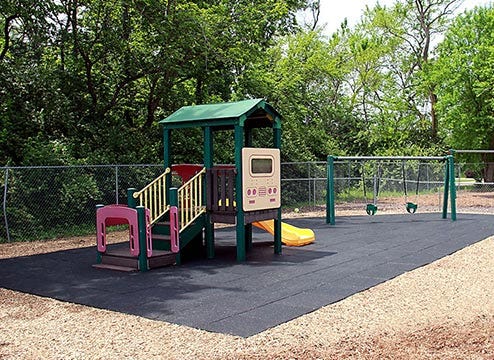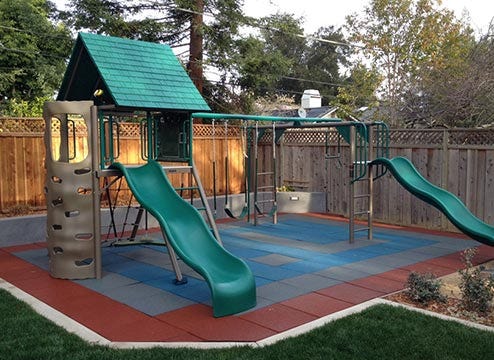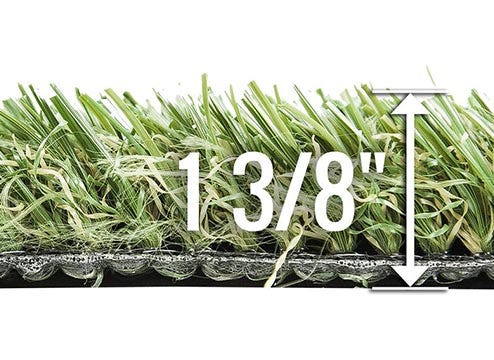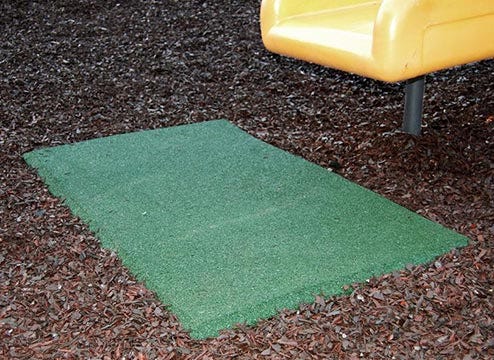
Outdoor Rubber Flooring for Playgrounds, Rooftops, Decks, and More
Outdoor rubber flooring is the ideal solution for safe, durable, and low-maintenance surfaces in any outdoor space. Whether you're upgrading a playground, building out a rooftop deck, or looking for rubber pavers for patios and walkways, our rubber flooring options are designed to perform in the toughest outdoor conditions.
From rubber playground tiles and rubber mulch for added fall protection, to rubber deck tiles and outdoor pavers that stand up to sun, rain, and heavy use—our collection is built for comfort, safety, and long-term durability.
Made from weather-resistant materials, our outdoor rubber products are slip-resistant, easy to clean, and simple to install. Use them for landscaping, walkways, patios, rooftops, or any area that needs a cushioned yet tough surface.
Eco-Friendly and Sustainable Rubber Flooring
Many of our rubber flooring products are made from recycled rubber—most commonly from used tires—which helps reduce landfill waste and repurpose materials that would otherwise be discarded. Choosing rubber flooring is a smart, sustainable option for anyone looking to create a more eco-conscious outdoor space. Plus, it lasts for years, reducing the need for frequent replacements and cutting down on overall material usage.
Types of Outdoor Rubber Flooring
Rooftop Deck Rubber Flooring
Transform any rooftop into a livable, stylish outdoor retreat. Our rooftop rubber tiles are engineered to be lightweight, easy to install, and gentle on roofing membranes. They provide a slip-resistant, cushioned surface that holds up against sun, rain, and heavy foot traffic—all while improving drainage and insulation.


Rooftop Deck Tiles
Deck Top Roof Tiles are the perfect solution for rooftop decks and high-rise outdoor spaces. Built for all climates, these durable rubber tiles feature a grooved underside that allows water to drain efficiently—protecting your surface while preventing pooling. Designed to install directly over delicate waterproof membranes, the tiles connect using dowels for added stability and long-term performance. Made from 100% post-consumer recycled rubber, they’re an eco-friendly choice that resists mold, mildew, and the elements. Backed by a 5-year warranty.
Horse Stall Mats
Our heavy-duty horse stall mats aren't just for barns—they're tough enough for outdoor spaces too. Use them in wash racks, feed areas, or other high-traffic zones where traction, durability, and cushioning are essential. These mats are made to take a beating while staying in place and performing year-round.


Horse Stall Mats
Made from thick, durable rubber, our horse stall mats are built to handle heavy wear—whether it’s from hooves, equipment, or foot traffic. They're also a popular choice for outdoor gyms, providing a stable, shock-absorbing surface that holds up to weights, weather, and workouts. These mats are slip-resistant, easy to clean, and offer long-lasting performance in any demanding environment, indoors or out.
Playground Rubber Flooring
Safety is non-negotiable when it comes to kids at play. Our rubber playground tiles and rubber mulch are designed to provide shock absorption, slip resistance, and all-weather durability. Whether it's a home backyard or a public park, rubber playground flooring helps reduce injuries from falls while offering long-lasting protection.


Playground Rubber Flooring
Our playground flooring options are available in a variety of thicknesses, colors, and styles to meet safety standards for different fall heights and design needs. Rubber playground tiles interlock securely for a seamless, trip-resistant surface, while rubber mulch provides a loose-fill alternative that’s low-maintenance and long-lasting. Both options are designed to stay in place, drain quickly after rain, and remain soft underfoot—making them ideal for swing sets, jungle gyms, and play zones of all sizes.
Playground Flooring Safety
THE ULTIMATE GUIDE
Birds are chirping, temperatures rising, spring is in the air! All across the country kids are cheering in gleeful unison that the time to go outside and play is upon us. Spring is the universal time of year where it is beautiful outside and families end their winter hermit ways and come out to play. As the season is just beginning, it’s the perfect time to think about putting in your very own playground, or updating your old, outdated equipment.
When it comes to playgrounds, you have a tons of options, but two things are mandatory: your playground must be safe and it must be fun! Lucky for you, this is pretty easy to achieve.
Simply start with a vibrant, durable and fall height safety rated* playground flooring, add sturdy, well-maintained equipment, a little common sense and you’re good to go. Before the fun starts, let’s take a moment to check in on our safety. Because hospital trips are not fun. Neither are broken bones.
*Fall height rating explained further down in this post.
Inappropriate Playground Surfaces
Before we talk about what you do want in your playground flooring, let’s get the heck no options out of the way first. Playground flooring must be shock absorbent. This means asphalt, concrete, dirt and gravel are out.
Think natural grass is soft? Maybe for a picnic, but not for landing after you jump from the swings! No, no, no, you need a specially designed playground flooring surface. We recommend an outdoor rubber. We’re big fans of rubber.
Inappropriate Playground Surfaces
Before we talk about what you do want in your playground flooring, let’s get the heck no options out of the way first. Playground flooring must be shock absorbent. This means asphalt, concrete, dirt and gravel are out.
Think natural grass is soft? Maybe for a picnic, but not for landing after you jump from the swings! No, no, no, you need a specially designed playground flooring surface. We recommend an outdoor rubber. We’re big fans of rubber.
Fall Height Ratings
For playground flooring, we talk a lot about “fall height.” The fall height is the highest point a child can safely stand on. If your playground flooring surface is fall height rated for 4′, that means the child can fall from 4′ without serious injury.
“Four-foot fall height is the ideal safety for a playground setting, creating an environment that’s substantially safer. It’s a very aggressive fall height for a residential setting.” – Bo Barber, VP ECORE International
The short story is that something like concrete would have almost no shock absorbency – you would not want your (or anyone’s) kid falling from tall playground equipment onto hard concrete! Thick, shock absorbent playground flooring is specially designed to keep kids safe at varying heights, so there is an option for every need.
The safety, fall height and shock absorbency is determined, mostly by the thickness of the tiles/mulch. In short, thicker tiles/mulch = higher fall height, meaning you can use higher playground equipment. Because safety is such a big concern, it’s super important to be diligent and make sure your flooring meets the safety standards. All playground tiles and playground mulch options have their own standards and safety criteria.
How is Fall Height Tested?
Fall height is determined by testing the shock absorbency of the flooring. Manufacturers perform tests that replicate a child falling from various heights to determine a height that a child can fall from without experiencing a serious injury. This helps the playground owner pair the best equipment with the right flooring to create the safest environment.
Historically, the test has been done by dropping a ball form representing the head of a child onto the center point of a floor tile. However, the International Play Equipment Manufacturers Association (IPEMA) recently changed the testing procedure so that the ball form is now dropped on the edge of the tile, the weakest point of the product.
“Tests performed on the middle part of the tile showed higher fall height ratings because that section has the most deceleration and shock absorption characteristics,” Barber said. “When you drop the ball form on the corner, where the tiles come together, the result is different.”
Playground flooring manufacturers must perform six tests and can only list the lowest fall height rating received. Some tests for a product may see a 6’ or even 8’ result, but if any test received a 4’ that is the number that must be reported.
This is why a number of playground flooring products have seen a drop in fall height ratings. The important thing that you need to know as the consumer is that nothing has changed about the way the tile has been made, only the testing procedure for determining fall height rating has changed.
Fall Height Recommendations
If a product has a lower fall height rating or has seen a significant drop in its rating, it doesn’t necessarily mean the product isn’t safe. The most important factor when purchasing playground flooring is ensuring that the product is fall height certified at all.
While a 6′ fall height rating is standard for most commercial playgrounds, residential and backyard play areas can get away with a product that has a lower fall height rating, such as 1’ or 2’. Typically, thicker tiles = higher fall height, meaning you can use higher playground equipment.
With playground designs and equipment getting bigger, it may be difficult to find a product that has a fall height rating matching that of the apparatus. For a tile to work up to a 10’ fall rating, it would need a foam backing on it, which Barber says is a challenge for any product. If you have a 10’ apparatus, Barber suggests buying a foam pad separate from the rubber tiles to improve the fall height rating.
Playground Tile Fall Height Ratings
We chatted about how the fall height rating for a playground tile is determined by the tile’s construction and thickness. Below is a breakdown of typical fall height safety ratings by thickness. It is important to note: these are the standard ratings, playground flooring safety but ratings vary by tile, so make sure to check out the specs on the specific safety surface you are looking at to ensure it will be safe.
- 1” → 1.5’ fall height, great for low height home playgrounds
- 1.5” → 2’ fall height, great for low height home playgrounds
- 1.75” → 3’ fall height, great for low height home playgrounds
- 2.25” → 4’ fall height, great for many home playgrounds
- 2.5” → 6’ fall height, great for most residential & commercial playgrounds
- 2.75” → 6’ fall height, great for most residential & commercial playgrounds
- 3.25” → 8’ fall height, great for most commercial playgrounds
- 3.5” → 8’ fall height, great for most commercial playgrounds
- 4” → 10’ fall height, great for most commercial playgrounds
Playground Tile Safety Tips
- Choose tiles that are fall height certified.
- Choose tiles that are free of lead and other dangerous chemicals.
- Sweep your rubber surface regularly to make sure there are no sharp objects.
- Choose a slip resistant material, such as rubber, to keep kids from slipping in the rain.
Playground Mulch
Playground mulch is your easier in the short term, a bit more maintenance in the long term playground flooring. Like our tiles, our outdoor rubber mulch has recommended thicknesses for fall height safety.
This requires a bit more maintenance because playground mulch can be displaced by play and weather, so it is important to measure regularly to make sure your playground flooring is still at a safe thickness.
A few benefits of using rubber playground mulch is that, unlike wood mulch, it does not absorb moisture, attract bugs, or magnetically pull cats from all over the neighborhood to use it as their own personal litter box.
Playground mulch, like playground tile, has different fall height safety ratings, depending on thickness. It is important to note: these are the standard ratings, but playground flooring safety ratings vary by product, so make sure to check out the specs on the specific product you are looking at to ensure it will be safe.
2” → n/a, recommended only for landscaping
3” → 6’ fall height rating, great for most residential playgrounds
6” → 17’ fall height rating, great for most commercial playgrounds.
Playground Mulch Safety Tips
- Measure your mulch thickness regularly to be sure you are still meeting safety regulations.
- Check playground mulch regularly for debris and sharp particles that may have gotten mixed in from the outside.
- Use rubber mulch to avoid scratches from traditional wood mulch.
- Surround your rubber mulch with rubber timbers to keep mulch contained in its designated area.
Shiny and Chrome anyone?
Playground Turf
Okay, so I know I just said grass is vetoed, but playground turf, that is another story. You can use artificial playground grass and still meet playground flooring safety guidelines.
Why?
Because with artificial turf, we can manipulate the thickness and add underlayment** to meet fall height safety regulations. So if you were super bummed when I was like hey girl, you can’t have grass in your playground, now you can jump for joy because hey girl, you totally can have a grass look in your playground!
And for the record, this is not the AstroTurf of the 80s. This playground turf looks and feels exactly like the real deal. In fact, if I were the betting type, I’d bet you good money that people won’t even know the difference!
**Underlayment is a material you can place under your flooring during installation. For more information, check out all of our underlayments.
Playground Turf Fall Height Ratings
Playground turf has different fall height safety ratings, depending on thickness and underlayment. Our playground turf requires a lawn pad underlayment to ensure fall height safety.
The thickness is measured by adding the thickness of your lawn pad with the thickness of your playground turf. It is important to note: these are the standard ratings, but playground flooring safety ratings vary by product, so make sure to check out the specs on the specific product you are looking at to ensure it will be safe.
- 2.1-3.1” → 5′ fall height rating, great for most residential playgrounds
- 3.3-4.3” → 7′ fall height rating, great for most residential & commercial playgrounds
Playground Turf Safety Tips
- Regularly clean turf to make sure there are sharp objects.
- Feel free to brush the turf to keep the blades from becoming smashed, causing uneven footing
Playground Mats
The first thing you need to know about playground mats is they are not recommended as a playground safety surface for falls. While our Swing Safety Mats do offer a 6′ fall height, it is necessary for your playground safety flooring to cover a much larger area, ensuring that children are safe anywhere they land.
Our rubber playground mats will protect you from scrapes and they will protect your flooring surface, especially under swings. They do provide a little extra cushion when coming down a slide or stairs, but they are not recommended as your primary playground flooring.
Other Playground Safety Tips
- Check equipment regularly: If there are cracks or rust, you need to fix it! Playground equipment ain’t gonna fix itself!
- Separate playgrounds by age: I know, I know, we all want to play with the big kids, but there are different playgrounds for a reason – safety!
- Watch your kids: Sounds like common sense, right? A little attention goes a long way for keeping your little one safe.
- Wear the right clothing: Sandals and pants that are too long are tripping hazards. A pair of close toed shoes and properly fitting shorts will make playtime so much easier.
- Use common sense: If something doesn’t seem safe, if there are strange characters lurking around, or if it’s 120 degrees, then head home for the day! You can always come back tomorrow.
Our rubber playground mats will protect you from scrapes and they will protect your flooring surface, especially under swings. They do provide a little extra cushion when coming down a slide or stairs, but they are not recommended as your primary playground flooring.










